 |
JAMES BOND
|
 |
JAMES BOND
|
|
||
|
|
1983 saw Sean Connery return as James Bond in Never Say Never Again, and marked the second time that two different actors were playing the character in films released in the same year. However, it was unusual to see principal actors returning as a different character, although several supporting players had appeared in different henchmen roles over the years. In 1971 an early draft of the screenplay for Diamonds Are Forever had proposed that the villain would be Auric Goldfinger's brother, with Gert Frobe returning to avenge the death of his sibling. Thankfully this far-fetched idea never made it any further than the scripting stage. |
||||
|
||||
|
Octopussy saw the debut of Robert Brown as M, replacing Bernard Lee, who had played the role in the first eleven James Bond films. Robert Brown had previously appeared as Admiral Hargreaves in The Spy Who Loved Me (1977) alongside Roger Moore and George Baker. As M was a designated title and not a person, one assumes Admiral Hargreaves was promoted to the head of the British Secret Service following the death of his predecessor. Out of respect for the much-loved Bernard Lee, producer Albert R. Broccoli had refused to recast the role following Lee's death in 1980, and his dialogue went to James Villiers playing Chief-of-Staff Bill Tanner, with the script changed to explain that M was on leave. Tanner himself had earlier been played by Michael Goodliffe in The Man With The Golden Gun (1974), and was a character created by author Ian Fleming, first appearing in his 1964 novel YOU ONLY LIVE TWICE as Bond's best friend in the Service. In 1965, Kingsley Amis wrote The Book of Bond or Every Man His Own 007, a tongue-in-cheek manual for prospective secret agents, illustrated with examples from Ian Fleming's novels. For this work, Amis used the pseudonym “Lt. Colonel William (‘Bill’) Tanner”. The character would pop up again in the EON Productions film series played by Michael Kitchen in GoldenEye (1995) and The World Is Not Enough (1999). In Quantum of Solace (2008) Tanner would be played by Rory Kinnear, who would then reprise the role in Skyfall (2012), Spectre (2015) and No Time To Die (2021). |
||||
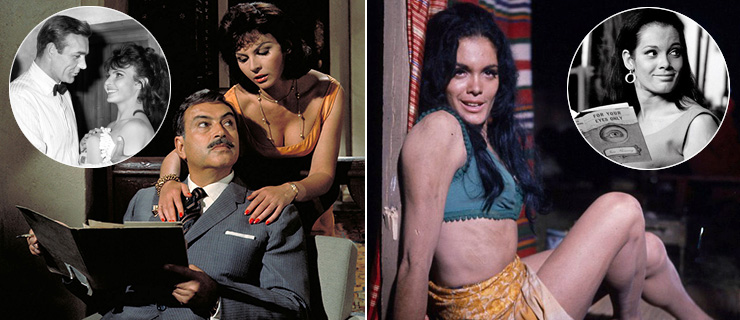 |
||||
|
The early James Bond films had seen two actresses returning to play different small roles. Billed as ‘Kerim's Girl’ in From Russia With Love (1963), Nadja Regin (above left with Pedro Armendariz) then appeared as Bonita (inset with Sean Connery) in the pre-credit sequence of Goldfinger (1964). Martine Beswick (above right), who had appeared as gypsy fighting girl Zora in From Russia With Love (1963), then played Bond's Bahamian contact Paula Catlin in Thunderball (1965). |
||||
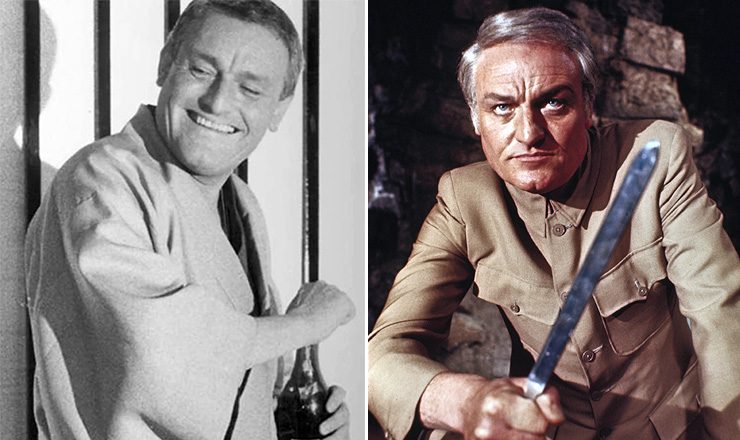 |
||||
|
The first film to feature a principal actor returning in a substantial role was Diamonds Are Forever (1971), which saw Charles Gray appear as Ernst Stavro Blofeld, four years after playing Henderson in You Only Live Twice (1967). In fact Gray's connection to the James Bond franchise goes back even further when he played Auric Goldfinger in Harold Sakata's screen test as Oddjob at Pinewood Studios on November 28, 1963. Charles Gray also served as the narrator [uncredited] for part of the Egyptian ‘Son et Lumiere’ sequence at the Pyramids of Giza in The Spy Who Loved Me (1977). |
||||
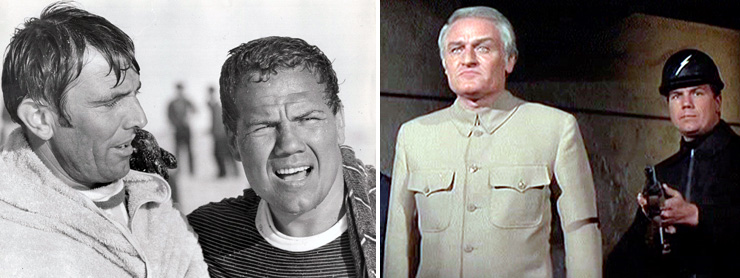 |
||||
|
Also appearing in the pre-credit sequence of Diamonds Are Forever (1971) as one of Blofeld's guards [uncredited] was Terence Mountain, who had previously appeared as Raphael in On Her Majesty's Secret Service (1969) in the spectacular pre-credit beach fight with George Lazenby as James Bond [pictured above left]. The Spy Who Loved Me (1977) then saw George Baker in the small supporting role of Captain Benson. Baker had earlier appeared as Sir Hilary Bray in On Her Majesty's Secret Service (1969), and also provided the speaking voice of George Lazenby in those scenes where James Bond impersonates his character. George Baker had also been considered (although never tested) for the role of James Bond in 1961. It has been reported in various media that George Baker also appears uncredited in You Only Live Twice (1967), something that his own Granddaughter, author Kim Sherwood, appears to believe is fact. At this stage in his career George Baker was an established character actor in both film and television, having recently appeared as ‘The new Number Two’ in the first episode of Patrick McGoohan's ground-breaking series The Prisoner. There is no reason to believe he would appear uncredited in anything, let alone a high-profile James Bond film! Coupled with the fact that the NASA sequences were for the most part made up from actual US stock-footage; there is no evidence to support the claim that George Baker appeared as a NASA engineer in You Only Live Twice. |
||||
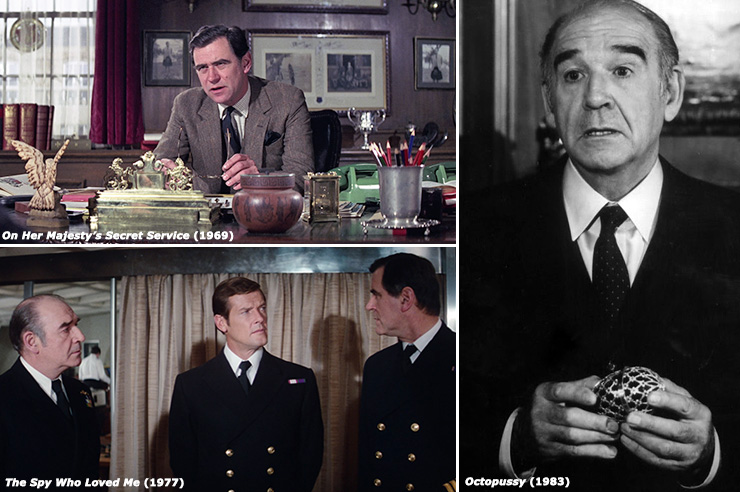 |
||||
|
Octopussy also saw Swedish-born actress Maud Adams return to the series. Playing the title role in the 13th James Bond film (although the character is not seen until over an hour into the storyline), Adams had appeared as the ill-fated Andrea Anders in The Man With The Golden Gun (1974). Later in the series American actor Joe Don Baker appeared as Jack Wade in GoldenEye (1995) - a role he would reprise in Tomorrow Never Dies (1997). Joe Don Baker had earlier played the significant role of arms dealer Brad Whitaker in The Living Daylights (1987) opposite Timothy Dalton as James Bond. |
||||
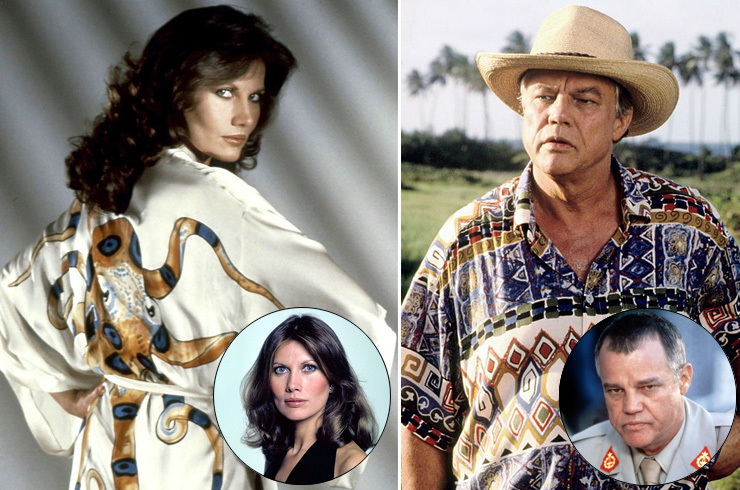 |
||||
|
Octopussy also saw Walter Gotell reprise his role as General Gogol for the fourth time. Gotell had first appeared as SPECTRE assassin Morzeny in From Russia With Love (1963), who met a fiery demise during the boat chase at the climax of the film. From Russia With Love also saw the return of Anthony Dawson [Professor Dent in Dr. No (1962)] this time as the character of Ernst Stavro Blofeld, but voiced by Eric Pohlmann - a role both artistes would reprise in Thunderball (1965), although uncredited on both occasions. |
||||
|
||||
|
||||
|
||||
|
In Roger Moore's final film as 007 he impersonates James St. John Smythe in order to infiltrate Max Zorin's (Christopher Walken) organisation. A View To A Kill also features Patrick Macnee as Sir Godfrey Tibbett, a racehorse trainer and MI6 agent who also ‘serves’ as St. John Smythe's chauffeur. The car he drives is a 1962 Rolls-Royce Silver Cloud II, which actually belonged to James Bond producer Albert R. ‘Cubby’ Broccoli. The car had the personalised number plate ‘CUB 1’, but for the film it was changed to ‘354 HYK’. The car is later seen being sunk in a lake to dispose of the body of Tibbett, and the presumably dead James Bond. The car sunk at Langley Park, Slough (close to Pinewood Studios) was an empty shell without an engine. Broccoli's Rolls-Royce was first seen briefly in Thunderball (1965) with its original ‘CUB 1’ number plate in the Shrublands car park, and has been used over the years at various film premieres and exhibitions of James Bond vehicles including ‘Bond in Motion’ Beaulieu 2012 [pictured below left]. Its most recent appearance was as part of the parade of James Bond cars seen in ‘The People’s Pageant’ - a once-in-a-lifetime procession [pictured below right] celebrating The Platinum Jubilee of Her Majesty Queen Elizabeth II on Sunday June 5, 2022. The car is still owned by EON Productions and was driven in the pageant by Academy Award winning director & stunt co-ordinator Vic Armstrong. |
||||
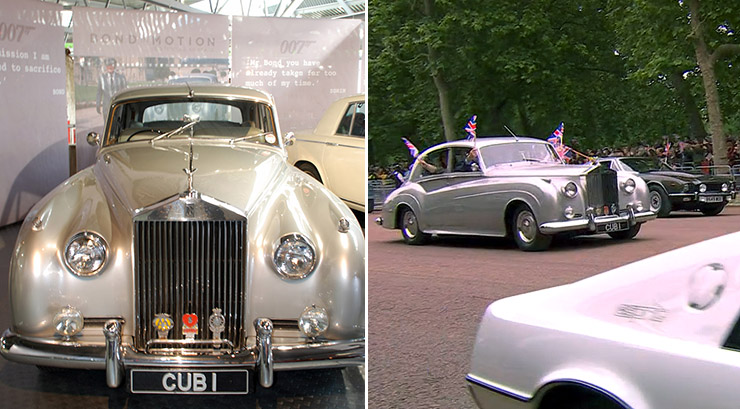 |
||||
|
||||
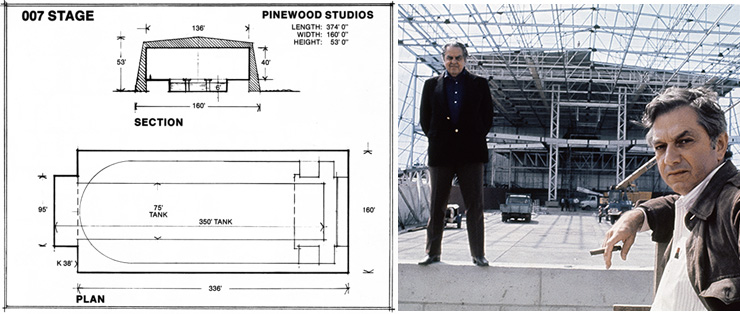 |
||||
|
The ‘007 Stage’ was originally conceived in 1976 by production designer Ken Adam [pictured above with producer Albert R. Broccoli] to house the set he designed for the interior of the Liparus supertanker in The Spy Who Loved Me (1977). Formally christened the ‘007 Stage’ on December 5, 1976 during a ceremony attended by former British Prime Minister Harold Wilson [pictured below left with Roger Moore and Barbara Bach]. In contrast to the volcano crater set Adam had built for You Only Live Twice in 1966, the ‘007 Stage’ was a permanent structure that was later rented out to other productions. |
||||
|
|
||||
|
On June 27, 1984, disaster struck when the ‘007 Stage’ burned down during the filming of Ridley Scott's Legend (1985). With production due to start on A View To A Kill (1985), EON Productions set about rebuilding the stage and it reopened on January 7, 1985 with another special naming ceremony. Pinewood renamed it the ‘Albert R. Broccoli 007 Stage’ in honour of the Producer’s contribution to the British film industry. |
||||
|
||||
|
Another fire occurred on July 30, 2006 just after production ended on Casino Royale (2006), while the Venetian piazza set was being dismantled. The fire-damaged stage was demolished on 13–14 September 2006. Construction on a new stage began four days later and was completed in under six months. Yet another accident happened during the filming of No Time To Die (2021) on June 4, 2019 when a controlled explosion resulted in partial damage to the exterior of the stage. Nobody on set was hurt, however one crew member outside the stage sustained a minor injury. |
||||
|
||||
|
In December 1970 American actor John Gavin was tested for the role of James Bond after George Lazenby had resigned the part after only one film. Gavin signed a contract and was announced as the new 007, but United Artists, financier and distributor of the James Bond films, were not convinced and still wanted Sean Connery to guarantee a box-office smash. The reluctant Scottish star finally relented and agreed to an unprecedented $1-million deal to return in Diamonds Are Forever (1971). Luckily, John Gavin had made a pay-or-play deal and received $50,000 for tearing up his contract. In 1986 history would repeat itself when Pierce Brosnan was the lead contender for the role of James Bond following the departure of Roger Moore after A View To A Kill (1985). |
||||
 |
||||
|
On June 27, 1986 the British press reported that Pierce Brosnan would soon be officially announced as the next James Bond. The actor had recently taken part in screen tests over three-days at Pinewood Studios [pictured above], discussed the role with the producers, and had a series of special photographs taken to promote his signing. Pierce Brosnan's availability following the cancellation of his US TV-series Remington Steele meant that he could start filming The Living Daylights in the Autumn of 1986. With renewed interest in the actor, production company MTM Enterprises reversed their decision to cancel the show, and Brosnan was obliged to fulfil the final year of his seven-year contract and work on the fifth season of Remington Steele. James Bond Producer Albert R. Broccoli was therefore forced to continue testing more actors in a bid to find the new 007. Eventually it was announced on August 7, 1986 that Timothy Dalton (who had been considered twice before for the role) would play James Bond in The Living Daylights. Dalton had taken part in a screen test at Pinewood Studios on Tuesday July 29, 1986. |
||||
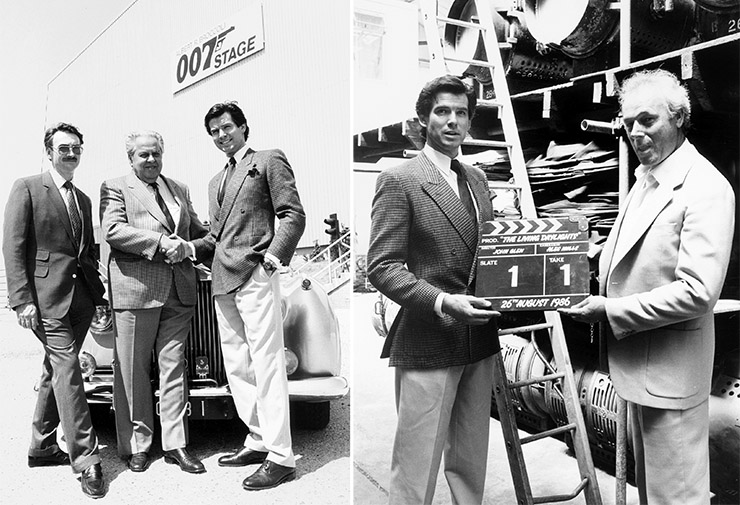 |
||||
|
Evidently the EON Productions publicity machine had been gearing up ready to announce Brosnan at a later date, as photographs of him at Pinewood Studios clearly attest. In addition to those of him supposedly signing the contract in June 1986, and meeting producers Albert R. Broccoli and Michael G. Wilson at the studios, another photograph of Pierce Brosnan with director John Glen holding a clapperboard [pictured above right] which bears the date 26th August 1986 (the day shooting was scheduled to begin on The Living Daylights), which was a full two weeks after Timothy Dalton had actually been announced as the new James Bond. |
||||
|
||||
|
The Living Daylights (1987) was the final James Bond film to be scored by John Barry (1933-2011), and the composer makes an uncredited appearance at the end of the film [pictured below left] as the conductor of the Vienna orchestra when Kara Milovy (played by Maryam d'Abo) plays in her World Tour as a concert cellist. The sequence was filmed at the Schloss Theatre, inside the Schonbrunn Palace, Vienna, Austria. The Living Daylights marked the end of a 25-year relationship between York-born John Barry and the James Bond films. However, there is another perhaps less well-known acknowledgement to the legendary 11-time James Bond composer in the film released in the series’ 50th Anniversary year. |
||||
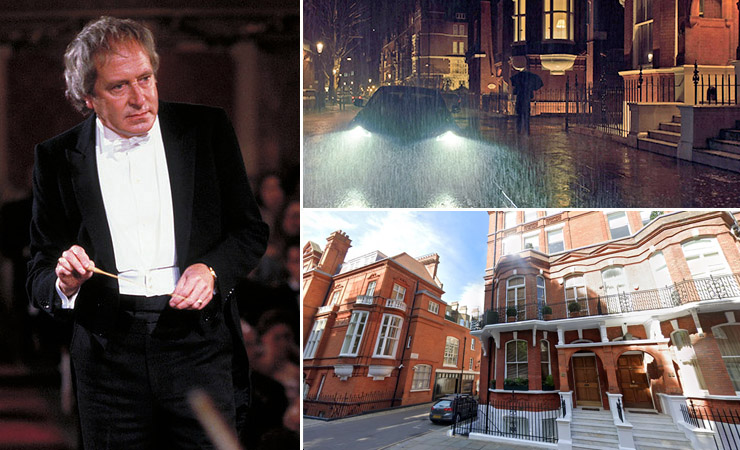 |
||||
|
In Skyfall James Bond (played by Daniel Craig) ‘returns from the dead’ and reports for duty after breaking into M's London home. The interiors were filmed on a sound stage at Pinewood Studios, but the brief exterior shot (above top right) was 82 Cadogan Square, in a desirable area of Knightsbridge. The five-story townhouse was once the home of John Barry, and included in the film as a tribute to the late composer, whose contribution to the series cannot be underestimated. Judi Dench (also born in York the year after Barry), who played M in Skyfall had made her first significant film performance in the drama Four In The Morning in 1965, which coincidentally featured a score by John Barry. The role (billed simply as ‘wife’) would win Dench the 1966 BAFTA award for Most Promising Newcomer to Leading Film Roles. The appearance of John Barry's former home in Skyfall (2012) was one of many references and ‘in-jokes’ celebrating 50 years of James Bond in the cinema, and unlike much of the material shoehorned into the 40th anniversary film Die Another Day (2002), was far more subtle and obscure, probably going unnoticed by the majority of the audience. |
||||
|
||||
|
The Ferris wheel where Bond (Timothy Dalton) and Kara (Maryam d'Abo) have a romantic rendezvous in The Living Daylights (1987) is the same one seen in the classic British post-war thriller The Third Man (1949), directed by Carol Reed. Situated in Vienna's Prater Park, the location had memorably served as the meeting place between Harry Lime (Orson Welles) and Holly Martins [Joseph Cotten pictured below left] in the 1949 classic. The Living Daylights director John Glen's first job was in the visual and sound editorial department for The Third Man. Fellow four-time James Bond director Guy Hamilton also worked on The Third Man as an assistant director. MI6 stalwarts Bernard Lee (M), Robert Brown (M), Geoffrey Keen (Frederick Gray, Minister of Defence) all appeared in The Third Man; and Eric Pohlmann, the voice of Blofeld in From Russia With Love (1963) and Thunderball (1965), also played the small role of a waiter. Orson Welles who played mysterious racketeer Harry Lime in The Third Man would later appear as Le Chiffre in Casino Royale (1967). |
||||
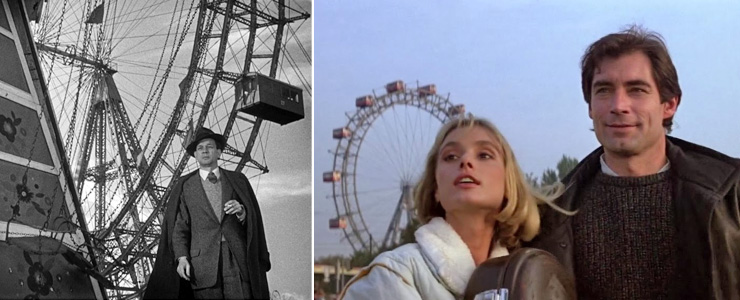 |
||||
|
In addition to the various actor connections between the two films, perhaps director John Glen's most memorable visual homage to The Third Man is Necros’ (Andreas Wisniewski) disguise as a balloon seller during the Prater amusement park sequence, which echoes the appearance of an aged balloon seller at the climax of Carol Reed's film - both characters even speak the same line of German dialogue: “Balloon, mein herr?”. The balloon motif is a precursor to the death of a significant character in both films - Sergeant Paine (Bernard Lee) in The Third Man, and Saunders (Thomas Wheatley) in The Living Daylights. |
||||
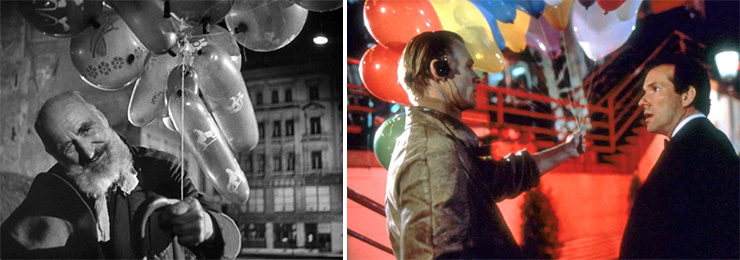 |
||||
|
||||
|
Although unknown at the time of its release, Licence To Kill (1989) marked the end of an era for many aspects of the James Bond series. Following the disappointing box-office returns for Timothy Dalton's second James Bond film, particularly in America, EON Productions regrouped and were considering a change of direction, resulting in long-time screenwriter Richard Maibaum and five-time director John Glen parting company with the series. Two key collaborators sadly passed away shortly after Licence To Kill was released. Richard Maibaum, who had been the series’ regular screenwriter since Dr. No (1962) died on January 4, 1991, followed by main title designer Maurice Binder on April 9th. Binder had also been with the series since Dr. No (1962), designing the opening gun barrel sequence, main titles and trailers for all subsequent films with the exception of From Russia With Love (1963) and Goldfinger (1964). Daniel Kleinman would take over as designer of the main titles in subsequent films [apart from Quantum of Solace (2008)], after directing the music video for Gladys Knight's title song ‘Licence To Kill’. |
||||
|
||||
|
Work on BOND 17 had begun in 1990 with a treatment co-written by Michael G. Wilson and Alfonse Ruggiero (then best-known for writing several episodes of the hit US TV series Miami Vice). The exterior facade of the Carlton Hotel then advertised the still-untitled BOND 17 during the 1990 Cannes Film Festival. Back in 1981 United Artists, the studio who financed and distributed the James Bond films went into bankruptcy, and had been acquired by Kirk Kerkorian's Tracinda Corp., who also owned Metro-Goldwyn-Mayer. This led to a series of mergers meaning UA was essentially dormant. In August 1990, Albert R. Broccoli put DANJAQ (the company formed in 1962 with Harry Saltzman to be responsible for the copyright and trademarks to the characters, elements, and other material related to James Bond on screen) up for sale and decided to hand over the job of producing films to his children. Michael G. Wilson was joined by his half-sister Barbara Broccoli as co-producer, although at this stage they were unable to actually make films. |
||||
|
||||
|
Italian promoter Giancarlo Parretti acquired MGM/UA in late 1990, and decided to sell the television and video rights to the James Bond films in order to help finance his $1.4-billion purchase of the studio from Kirk Kerkorian. As part of their 1962 contract with United Artists, DANJAQ had originally owned 50% of the rights to make the James Bond films, but in 1975 Harry Saltzman's personal financial difficulties forced him to sell his half share to United Artists. In 1986, Albert and Dana Broccoli had acquired United Artists’ stake in DANJAQ, and assumed complete control of the company, with MGM/UA receiving an exclusive distribution deal as part of the sale. DANJAQ filed suit against Pathé Communications (MGM/UA's parent company), and claimed that then-owner Parretti had breached their original 1962 contract by selling the distribution rights. A long legal battle ensued effectively preventing any new James Bond films being made, although September 1991 had seen the American television debut of the ill-advised James Bond Jr. cartoon series. The legal proceedings were not fully resolved until 1993, by which time actor Timothy Dalton's original seven-year contract had expired. Pre-production resumed on BOND 17 in early 1994 with a new storyline from screenwriter Michael France. Although keen to complete a third James Bond film, Timothy Dalton declined to sign another multi-picture contract, and ultimately announced his resignation from the role of James Bond on April 12, 1994. Pierce Brosnan was then revealed as his replacement on June 8, 1994, after losing the role to Dalton in 1986. |
||||
 |
||||